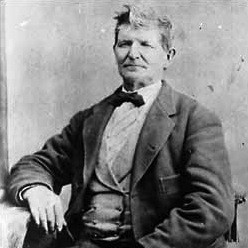
1812 - 1877
John Doyle Lee
Summary
Name:
John Doyle LeeYears Active:
1857Birth:
September 06, 1812Status:
ExecutedClass:
Mass MurdererVictims:
120Method:
Mass executionDeath:
March 23, 1877Nationality:
USA
1812 - 1877
John Doyle Lee
Summary: Mass Murderer
Name:
John Doyle LeeStatus:
ExecutedVictims:
120Method:
Mass executionNationality:
USABirth:
September 06, 1812Death:
March 23, 1877Years Active:
1857Date Convicted:
September 20, 1876bio
John Doyle Lee was born on September 6, 1812, in Kaskaskia, Illinois Territory, during the early years of westward American expansion. His early life was deeply tied to the birth of the Latter Day Saint movement, and by 1838, he became a committed convert to the Church of Jesus Christ of Latter Day Saints. Lee quickly rose in rank and trust, forging a personal friendship with Joseph Smith, the church's founder. Under early church practices, he was adopted as a spiritual son by Brigham Young, who later became the second president of the LDS Church.
Lee devoted his life to church activities. In 1839, he embarked on a missionary journey with his childhood friend Levi Stewart, preaching across Illinois, Ohio, Kentucky, and Tennessee. One of his notable converts during this time was “Wild Bill” Hickman, who would later gain infamy of his own in the American West.
A staunch believer in plural marriage, Lee married 19 women over his lifetime and fathered 56 children, although many of his wives eventually left him. He held several important roles within the LDS Church. He was a member of the Danites, a secretive Mormon vigilante group formed in the 1830s, and also served as a scribe for the Council of Fifty, a church leadership body that played a pivotal role in organizing the migration of Latter Day Saints to the American West.
Lee was instrumental in founding several settlements in Utah and Arizona. Notably, he helped establish Lee’s Ferry and the Lonely Dell Ranch near what is now Page, Arizona. In 1856, he was appointed a U.S. Indian Agent for the region, helping Native tribes transition into farming life. In 1858, Lee also served as a member of the Utah Territorial Legislature.
murder story
In September 1857, tensions between the Mormon community and the U.S. government had reached a breaking point. As part of the Utah War, Mormons feared an invasion by federal troops. This climate of fear and religious zealotry set the stage for the Mountain Meadows Massacre, a coordinated attack on a group of westward emigrants known as the Baker–Fancher party.
The emigrant wagon train, traveling from Arkansas to California, stopped to rest at Mountain Meadows, a known staging area before crossing the Mojave Desert. Between September 7–11, 1857, the party was besieged by a group of Mormon militia disguised as Native Americans, along with actual Paiute tribal members. The siege lasted for days.
On the final day, September 11, John D. Lee, dressed in his own clothes (not in disguise), approached the emigrants under a white flag of truce. He convinced them to surrender peacefully in exchange for protection and safe passage to nearby Cedar City. Believing they had no other choice, the group disarmed and followed Lee’s instructions.
What followed was a carefully orchestrated massacre. Roughly 120 men, women, and older children were killed in cold blood by Mormon militia members and Paiutes. Only 17 young children, considered too young to remember or testify, were spared.
After the massacre, Lee and others claimed that the Native Americans alone were responsible, and he told Brigham Young that "no white men were mixed up in it." But as time passed, more facts came to light, and federal investigators began to probe the event more seriously.
For many years after the massacre, Lee continued to live in Utah and remained active in both the church and local government. However, as public outcry grew and the federal government increased scrutiny on the massacre, the LDS Church eventually excommunicated Lee in 1870.
In 1874, nearly 17 years after the killings, John D. Lee was arrested and charged with orchestrating the massacre. His first trial ended in a hung jury, largely due to attempts by the defense to implicate Brigham Young and other church leaders. In a second trial in 1876, the prosecution changed its strategy, focusing entirely on Lee. He was found guilty of first-degree murder and sentenced to death.
Lee claimed he had acted under orders and had not personally killed anyone. He consistently portrayed himself as a scapegoat, sacrificed to protect more prominent Mormon figures. In his posthumously published “Life and Confessions of John D. Lee,” he hinted that Brigham Young had indirect involvement or foreknowledge, suggesting General George A. Smith had been sent to prepare locals for the attack.
On the morning of March 23, 1877, John Doyle Lee was executed by firing squad at the exact site of the Mountain Meadows Massacre. In one of the most iconic execution photographs of the 19th century, Lee is shown seated on his own coffin, moments before his death. His last words included a clear renunciation of Brigham Young: “I do not believe everything that is now being taught and practiced by Brigham Young… It is my last word.”
Over 80 years later, on April 20, 1961, the LDS Church posthumously reinstated John D. Lee’s membership, acknowledging his role in church history but not reversing the moral weight of his actions.